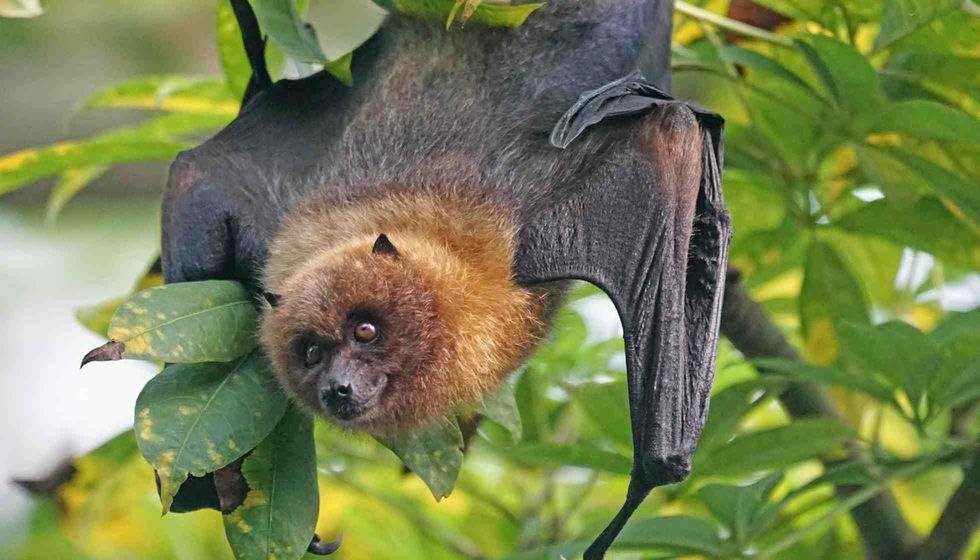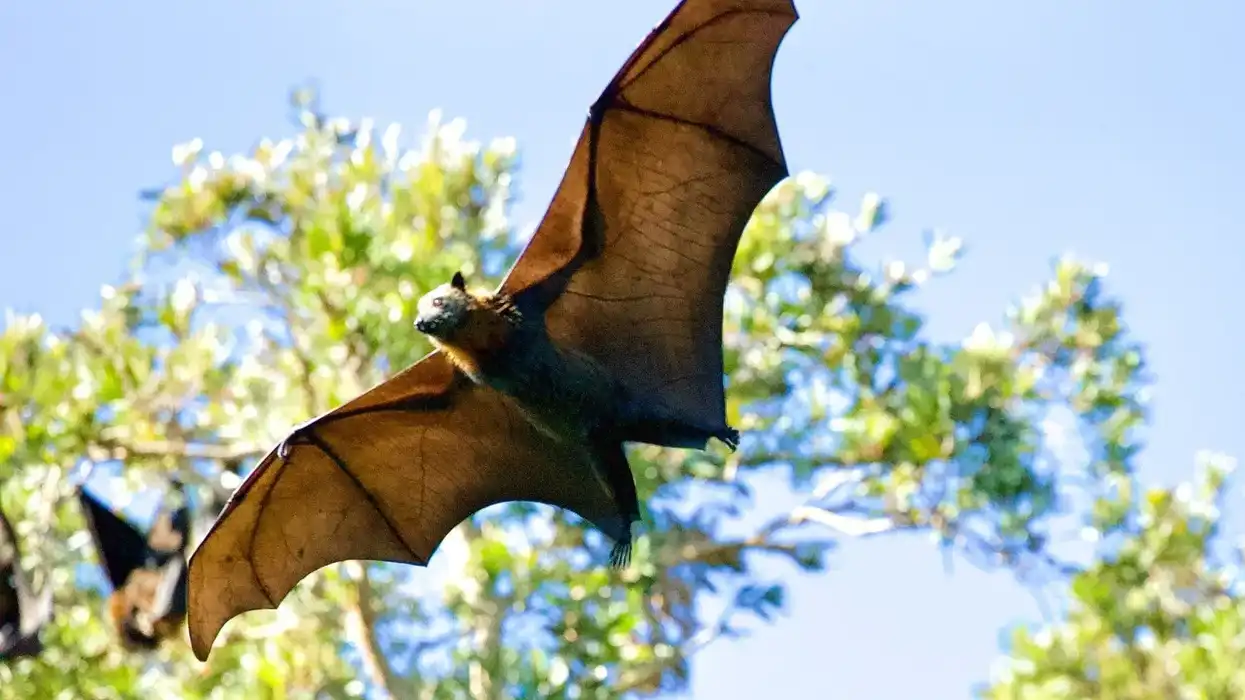Let's get started on some interesting fruit bat facts. Fruit bats are one of the largest species of bats in the world belonging to the genus Pteropus. They are often referred to as frugivore as they thrive on raw fruits.
Hence the name fruit bat. They are also called flying foxes as their heads resemble foxes because of their short snouts, bright eyes, and pointy ears.
The fruit bat habitat constitutes tropical forests, savannas, or islands in Australia, Asia, and Africa. They have large wings with a span of approximately 59 in (1.5 m). They are also called megabats because of their large size.
They are known to have a strong sense of smell which helps them to locate food or roosting spots. Females use it to locate their pups.
Their roosting groups are called colonies. Their predators include hawks, eagles, and snakes. According to the International Union for Conservation of Nature or IUCN Red List, some of the species are critically endangered, vulnerable, and near-threatened.
Read on to learn about the fruit bat, scientific name Pteropus. You may also like to read red bat and flying squirrel facts.
Fruit Bat Interesting Facts
What type of animal is a fruit bat?
Fruit bats are a type of bats that are mammals belonging to the genus Pteropus.
What class of animal does a fruit bat belong to?
They belong to the class Mammalia and a part of the family Pteropodidae. The fruit bat's scientific name is Pteropus.
How many fruit bats are there in the world?
There is no exact data about the number of individuals but they are mostly concentrated in dense forests of southeast Asia, Australia, and Africa.
Where does a fruit bat live?
They live in parts of Asia, Africa, Australia, and the islands. Indian fruit bats are mostly concentrated in India, Bangladesh, Bhutan, Tibet, and Pakistan. The Egyptian fruit bat is found in the Mediterranean, Middle East, and India.
The pygmy fruit bat resides in Sumatra, Java, and Malaysia. The Samoan fruit bat is found in Fiji and Samoa. The black fruit bat is native to Australia, Indonesia, and New Guinea.
The Mexican fruit bat is found in Mexico, Central, and South America. Straw-colored fruit bats are mainly found in sub- Saharan Africa.
The Livingstone's fruit bat is found in Moheli islands and Anjouan in the Indian Ocean. The Buettikofer's epauletted fruit bat is found in Nigeria, Senegal, Ghana. The African fruit bat is also found on Pemba Island, Tanzania.
What is a fruit bat's habitat?
Fruit bats are generally found in tropical and subtropical forests. These areas contain trees in very close proximity and receive more than 78.7 in (200 cm) rainfall annually along with the high temperature.
They also reside in savanna grasslands characterized by trees that are widely spaced allowing sunlight to enter the floor. Fruit bats are also found in oceanic islands and forests in temperate zones. During the day they roost on tall trees in the forests.
Who do fruit bats live with?
Fruit bats live in large social groups called colonies or camps. Their colonies contain around 15,000-1,00,000 individuals. However, some of them roost alone.
How long does a fruit bat live?
Fruit bats have an average lifespan of 15 years.
How do they reproduce?
Fruit bats are mostly seasonal breeders although some of them can breed throughout the year. They mate at the roost. Due to varied reproductive adaptations among the species, the timespan between copulation and females giving birth is different for all.
The gestation period ranges between four to six months. The females give birth to one offspring or pup. Rarely do they give birth to twins and the chances of survival of both the offsprings are very low.
They have low reproductive output. The female fruit bats do not participate in reproduction until the age of one or two. Females usually take care of the pup.
Male bats generally do not assist in the process. Weaning period of the young starts at seven to eight weeks of age. In Indian fruit bat, it reaches up to five months of age.
What is their conservation status?
According to the International Union for Conservation of Nature or IUCN Red List, four species of fruit bats are listed as Extinct, eight species as Critically Endangered, 16 species as Endangered, 37 species as Vulnerable, 13 species as Near Threatened and 89 species as Least Concern.
Large-scale destruction of habitat, hunting for food and medicinal use, natural disasters, and climate changes are a few of the major causes for the dwindling number of fruit bats.
Fruit Bat Fun Facts
What do fruit bats look like?
The fruit bat is also called the flying fox as its head resembles that of a fox, with a short snout, bright eyes, and pointed ears. They are quite large in size when compared to other species of bats. Their size ranges from 6-12 in (15-30 cm).
Forearms are modified into wings that reach up to 59 in (1.5 m). Along with flight, the large wing helps in keeping them warm.
The size and color of fur vary from one fruit bat species to another. The wings of the Jamaican fruit bat are dark gray in color. The Golden capped fruit bat has a golden color extending between its eyes and neck.
It has black and reddish-brown fur on the face, neck, and throat. The Egyptian fruit bat has a grayish-brown coat with a yellowish-brown collar on the neck.
The Mindoro stripe-faced fruit bat has an overall orange plumage with a white beak and white spots above the eyes. The fruit bat skeleton shows that they have a large orbit. They also have sharp claws on their toes.

How cute are they?
Their cuteness usually stems from their appearance. They have a fox-like faces with pointy ears and bright eyes. The body is covered with fur. They also have the largest wings among all the other bat species which they wrap around themselves while roosting.
How do they communicate?
Fruit bats are highly social and communicate by a sharp vocalization of high frequency. Their calls sound like honking or piercing trills.
The Egyptian fruit bat has a special way of communication where they modify their voices when interacting with individuals of their own species. A young Egyptian fruit bat obtains a dialect from its mother or other members of their colonies which is unique.
They generally communicate to guard their territories, to protect themselves or others from predators, or during breeding seasons to attract mates.
How big is a fruit bat?
Fruit bats are the largest bat species. They range between 6-12 in (15-30 cm) in length which is almost six times the size of a bumblebee bat which is 1.1-1.3 in (2.7-3.3 cm).
How fast can a fruit bat fly?
Fruit bats can fly at a speed of 12-31 mph (20-50 kph). They fly faster than most bats although some of them are slower. They fly at night in search of food or places to roost.
How much does a fruit bat weigh?
The fruit bat weighs around 0.3 lb-3.5 lb. The great flying fox (Pteropus neohibernicus) is the largest among all megabats weighing up to 3.5 lb. Males are slightly larger and weigh more than females.
What are male and female names of the species?
Scientists do not have separate names for male and female fruit bats. They are generally referred to as male fruit bats and female fruit bats.
What would you call a baby fruit bat?
The baby is usually called a pup.
What do they eat?
The flying fox is a herbivore and feeds on leaves, fruits, flowers. nectar, pollen, sap, bud, and twigs. They are referred to as frugivore as they thrive on raw fruits. Figs, rose apples, and tamarind are some of the fruits they like eating.
Are they dangerous?
Fruit bats like other bats are associated with a variety of diseases that can be transmitted to humans. One of the main diseases is rabies caused by the Lyssavirus. It occurs when an infected animal bites or scratch someone or through contamination of open wounds with their saliva.
The flying fox also carries the Hendra virus which transmits to humans indirectly through infected horses. Another common disease carried by bats is the Nipah virus.
It spreads to humans directly through the bats or through an intermediate host such as infected pigs. A Nipah virus outbreak has been noted in India, Bangladesh, Malaysia. Most of it can be fatal so fruit bats can be considered dangerous to human beings.
Would they make a good pet?
They might show signs of fear, aggression, or extreme loneliness in confinements. They generally do not bite but they might if provoked. They are best left in the wild. In some countries including the U.S., it is illegal to keep a fruit bat pet. They also carry a variety of diseases that can be fatal if transmitted to humans.
Did you know...
Flying foxes or fruit bats are the most intelligent species among the bats. The ratio of their brain size to body size or the encephalization quotient is the maximum.
The value of it is 1.2 which is equal to that of a domestic dog. The Egyptian fruit bat has the highest encephalization quotient among others. They have a long-term memory.
A flying fruit bat travels a long distance but is still able to locate the exact place where it roosts with a method known as trap lining.
Fruit bat drawing can be done following some simple steps. First, the outline of the head and body should be drawn, then the detailing of the eyes and ears should be done. Following which the large wings on both sides, two legs containing toes with pointed claws should be drawn.
Are fruit bats blind?
Fruit bats do not use echolocation, that is to determine locations through echoes of their calls. In fact, they use their sharp vision to navigate especially at night.
They are dichromatic which means their eyes contain both rod cells and cone cells which allows them daylight and night vision. Their eyes are situated in front of their heads and help in binocular vision.
How good is a fruit bat's vision compared to other species of bats?
The fruit bat has the best overall vision among the bat species. Unlike other bats who echolocate to navigate, they use their sharp dichromatic binocular vision.
Here at Kidadl, we have carefully created lots of interesting family-friendly animal facts for everyone to discover! Learn more about some other mammals including Mexican free-tailed bat, or hoary bat.
You can even occupy yourself at home by drawing one on our fruit bat coloring pages.










